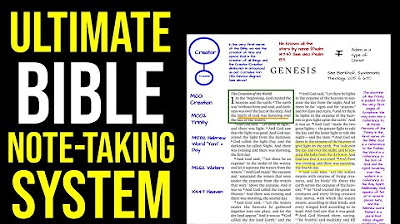Symbols: dos and don'ts
Summary
TLDRThe video discusses the effective use of symbols in consecutive note-taking, emphasizing that symbols alone won't solve problems unless part of a structured system. It explores why interpreters use symbols (speed, space-saving, and concept representation) and what should be replaced with symbols, especially recurring concepts. The video stresses the importance of clarity, consistency, and preparation in symbol use. It advises creating personalized, memorable symbols and highlights the value of organic symbols, like arrows or boxes, that evolve into related meanings. Overall, symbols should naturally integrate into note-taking practice.
Takeaways
- 💡 Symbols are useful in interpreting, but they must be part of a structured note-taking system to be effective.
- ❓ The key questions to ask about symbols are not how many to use, but why, what to replace, and how to use them effectively.
- ⚡ Symbols are faster to write and read than words, saving time and improving efficiency.
- 🔄 Symbols represent concepts rather than specific words, giving interpreters flexibility in choosing the right term during interpretation.
- 📝 Symbols save space on the page, allowing for a clearer layout and structure in notes.
- 🔁 Commonly recurring concepts (e.g., think, say, know, propose) and frequent terms in a specific context (e.g., telecommunications) are ideal candidates for symbol replacement.
- 🔑 Symbols must be clear, unambiguous, and consistent to avoid confusion during interpretation.
- ⚙️ It's important to prepare symbols in advance; improvising symbols on the spot can lead to mistakes later.
- 💭 Symbols should resonate with the user personally, meaning they need to make sense to the individual using them.
- 🌱 Organic symbols are helpful because they can build related concepts from a single root symbol, like arrows representing movement or changes.
Q & A
What is the main message of the video regarding the use of symbols in consecutive interpreting?
-The main message is that symbols alone won't solve problems unless they are part of a consistent and structured note-taking system.
Why do many students ask about symbols when learning consecutive interpreting?
-Students are curious about symbols because they see them as a tool for simplifying consecutive note-taking, especially since symbols can be quicker to write and easier to interpret than words.
What are the benefits of using symbols in consecutive interpreting?
-Symbols are quicker to write and read, represent concepts rather than specific words, save space on the page, and offer flexibility when interpreting since they are not tied to a particular word.
What are the two main types of things that can be replaced with symbols?
-The two main types are (1) concepts that recur frequently in speeches, such as 'think,' 'say,' or 'support,' and (2) topics that are specific to a particular day or session, like telecommunications during a specific conference.
Why is it important that symbols are clear and unambiguous?
-Clear and unambiguous symbols ensure that the interpreter won’t confuse their meaning when reviewing notes under pressure, improving the reliability of the notes during interpreting.
What should interpreters do to prepare their symbols in advance?
-Interpreters should create and familiarize themselves with symbols before the interpreting session, ensuring that each symbol is meaningful to them and easily recalled.
Why is it not recommended to use symbols created by someone else without modification?
-Symbols need to resonate personally with the interpreter, meaning that symbols from other people might not be intuitive or memorable for someone else, making them less effective.
What does the video mean by 'organic' symbols?
-Organic symbols are symbols that serve as a root and can be adapted to represent related concepts. For example, an arrow can indicate rising, falling, or deriving, depending on its orientation.
What are the characteristics of a good symbol in consecutive interpreting?
-A good symbol is easy to remember, unambiguous, consistent, prepared in advance, and meaningful to the user. Good symbols also have a structure that allows for variations to represent related ideas.
What should you do if you find yourself forgetting a symbol?
-If you forget a symbol, it likely wasn’t a good symbol to begin with. You should allow yourself to forget it and focus on symbols that are intuitive and memorable through repeated use.
Outlines

Esta sección está disponible solo para usuarios con suscripción. Por favor, mejora tu plan para acceder a esta parte.
Mejorar ahoraMindmap

Esta sección está disponible solo para usuarios con suscripción. Por favor, mejora tu plan para acceder a esta parte.
Mejorar ahoraKeywords

Esta sección está disponible solo para usuarios con suscripción. Por favor, mejora tu plan para acceder a esta parte.
Mejorar ahoraHighlights

Esta sección está disponible solo para usuarios con suscripción. Por favor, mejora tu plan para acceder a esta parte.
Mejorar ahoraTranscripts

Esta sección está disponible solo para usuarios con suscripción. Por favor, mejora tu plan para acceder a esta parte.
Mejorar ahora5.0 / 5 (0 votes)






